With tiny wide-set eyes, large whiskered snouts that seem to always be smiling, and slow graceful movements, dugongs (Dugong dugon) have an ancient air of wisdom about them. Dugongs have captured the human imagination for centuries with their gentle nature and peculiar appearance. These gentle ocean giants may seem sluggish, but they are powerful swimmers and can propel their large bodies effortlessly through the water with surprising speed. From their unique feeding habits to their remarkable communication skills, dugongs are extraordinary, one-of-a-kind sea creatures. So, let’s dive in and learn some incredible dugong facts!
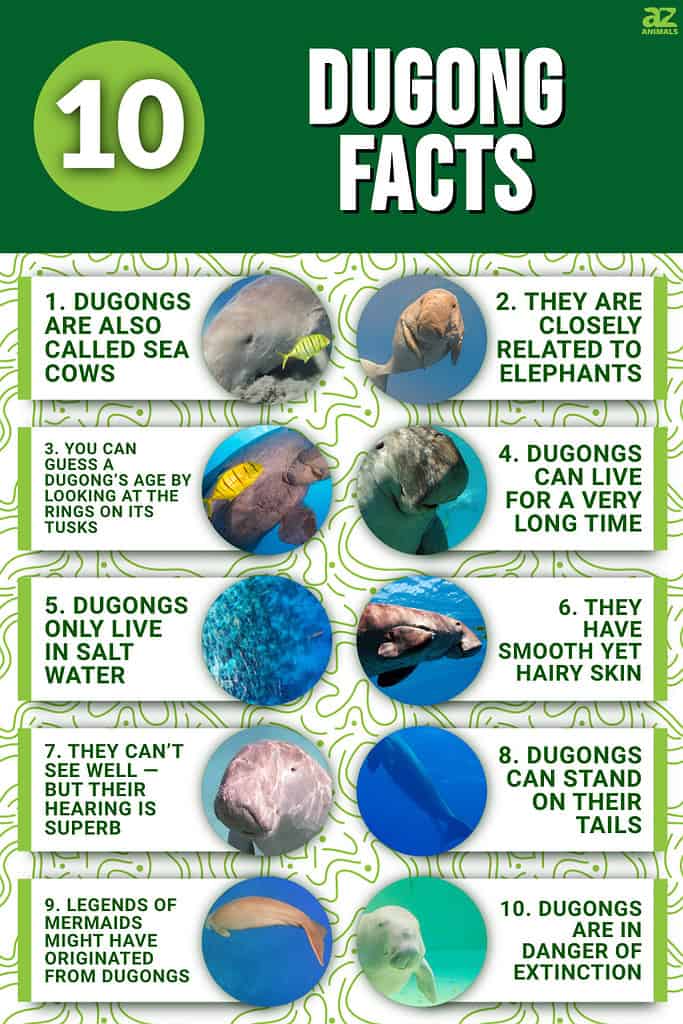
1. Dugongs Are Also Called Sea Cows

As the only herbivorous marine mammal in the world, dugongs feed mostly on seagrass.
©Laura Dts/Shutterstock.com
Dugongs have very muscular cleft upper lips that stick out over their mouths. These bristled and ultra-sensitive snouts are very strong and allow dugongs to root around the ocean floor and grab seagrass. They are the only herbivorous marine mammals in the world, and seagrass makes up most of their diet. Dugongs spend both night and day grazing on a variety of underwater seagrasses, kind of like a bunch of aquatic-looking cows — hence why they are sometimes called “sea cows”!
2. They are Closely Related to Elephants
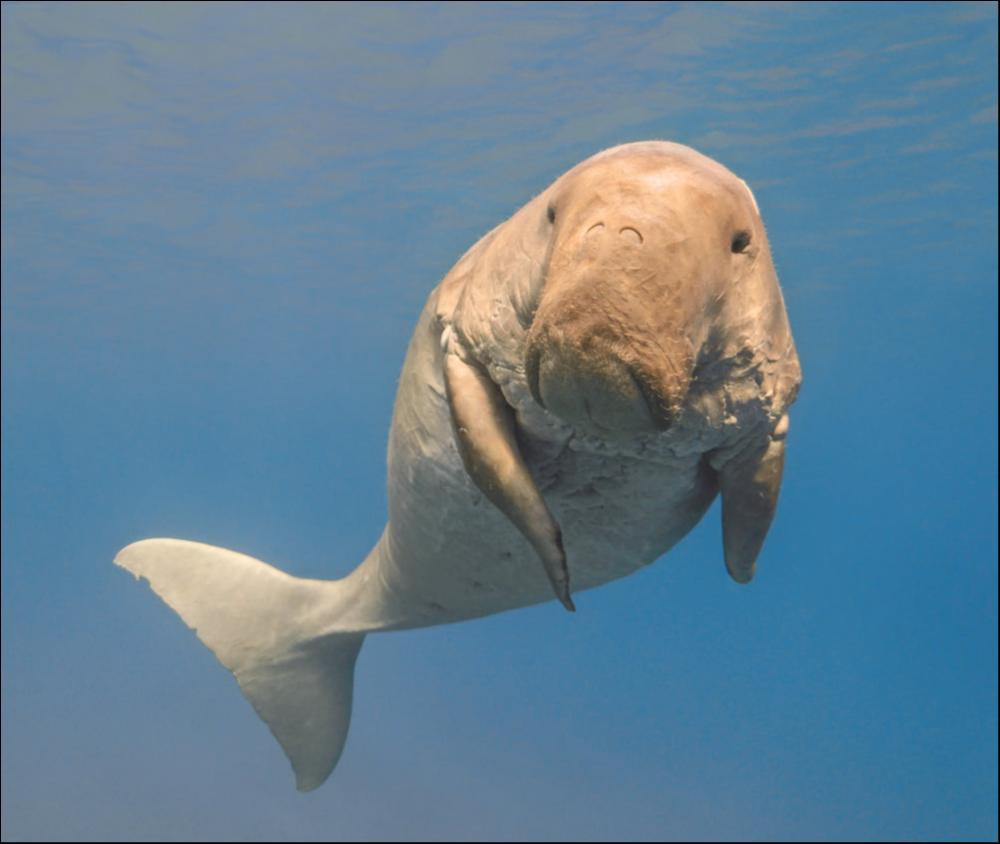
Scientists believe that dugongs descended from land animals. In fact, they’re closely related to
elephants
.
©vkilikov/Shutterstock.com
There were once other Dugongidae species like dugongs in the oceans, like the Steller’s sea cow (Hydrodamalis gigas). Sadly, the Steller’s sea cow became extinct in the 18th century due to hunting by humans — so dugongs are now the last surviving member of the family Dugongidae.
Dugongs are also one of four species that belong to the order Sirenian and are related to manatees. They may look like chubby dolphins or porpoises, but scientists believe that dugongs and manatees are descended from land animals. In fact, Dugongs are actually more closely related to elephants than to other marine animals! Dugongs even grow tusks like elephants.
3. You Can Guess a Dugong’s Age by Looking at the Rings on Its Tusks

The rings on a dugong’s tusks give away its age.
©Verde Massimo/Shutterstock.com
The tusks of a dugong are actually just two elongated front teeth. These stick out from their mouths and have sharp, angled edges. But not all dugongs have these magnificent tusks — only mature males and some older females are lucky enough to grow a pair of these tremendous teeth.
Not only do some dugongs sport impressive tusks — their tusks also can help us guess how old they are! Dugong tusks have growth layer groups (GLGs) that look like rings. These are made up of a thick, dark section and a thinner, lighter section. Scientists think that each year, a new GLG is added to a dugong tusk, which can help them estimate the dugong’s age.
4. Dugongs Can Live for a Very Long Time
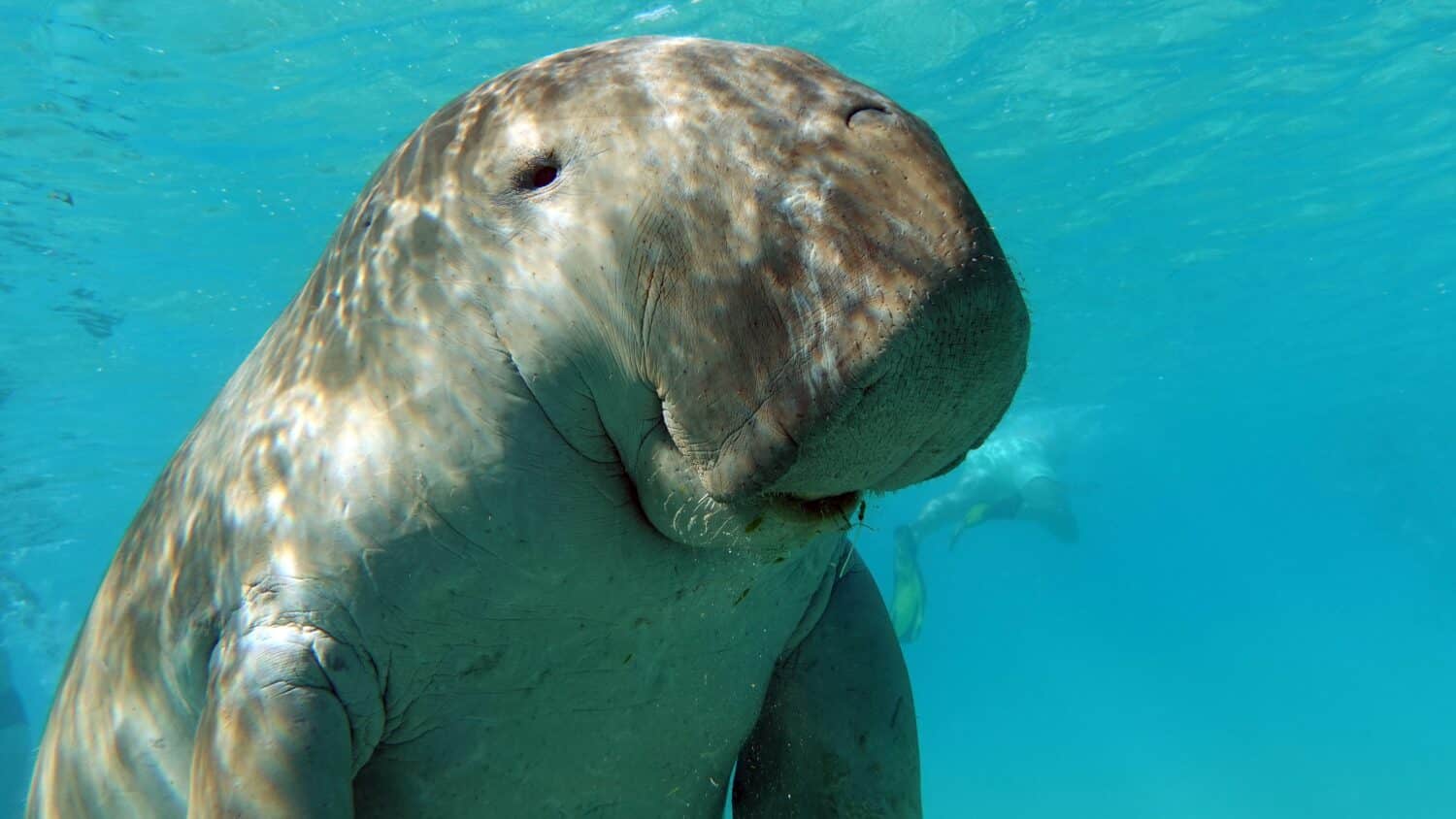
Some dugongs aren’t fully grown until they are between 10 and 20 years old.
©Vitaliy6447/Shutterstock.com
When dugong babies are born, they are only around 3 or 4 feet long and weigh 44 to 77 pounds. That may not seem all that small, but a fully grown dugong can grow up to 10 feet long and weigh over 1,000 pounds! However, it does take a long time for a dugong to get that big. Depending on where they live, some dugongs are not fully grown until they are at least 10 to 20 years old! Fortunately, dugongs do have pretty long lifespans and can live around 60 to 70 years. In fact, the oldest dugong on record lived to be 73 years old!
5. Dugongs Only Live in Salt Water
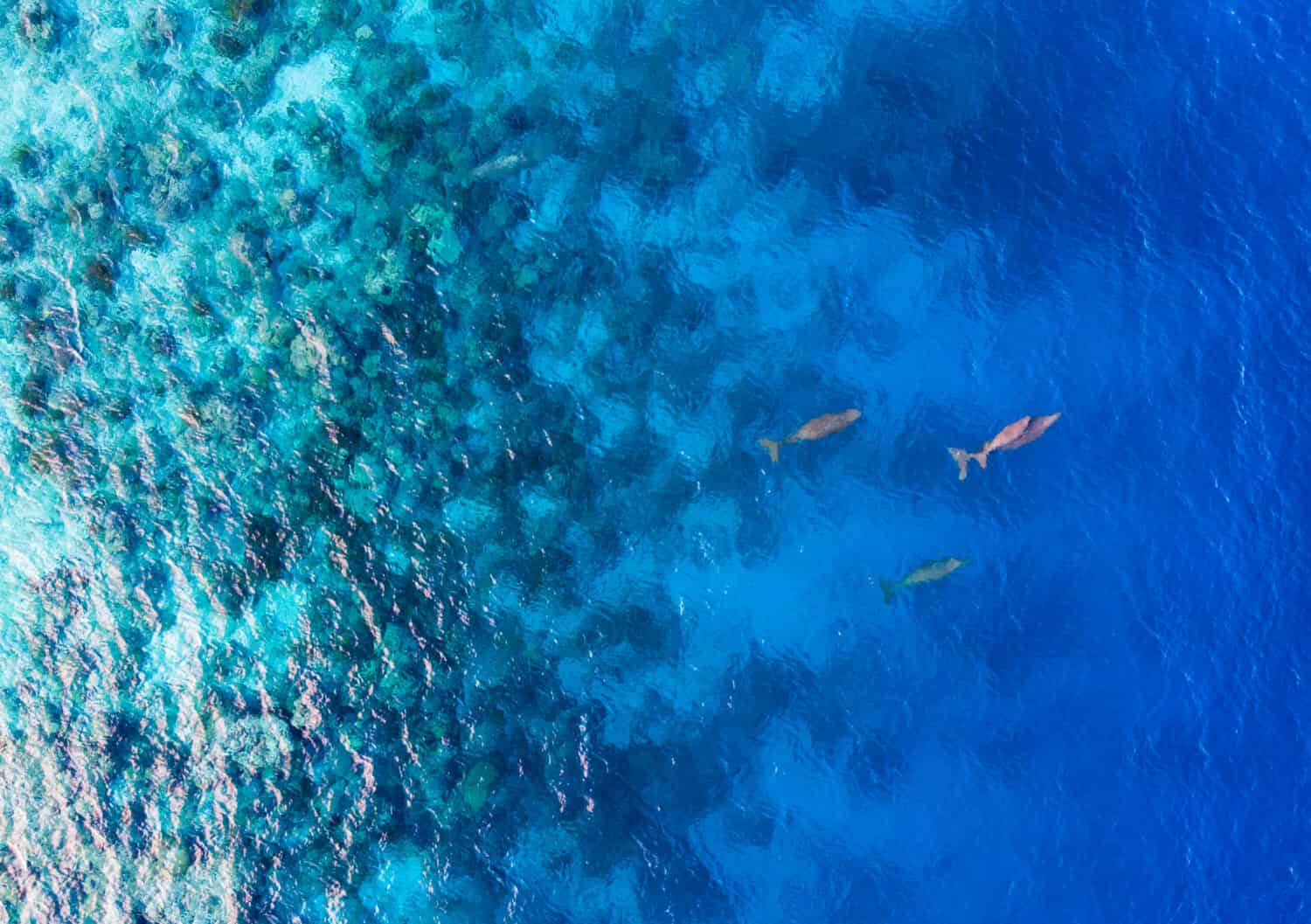
Unlike manatees, dugongs only live in salt water.
©Bastian AS/Shutterstock.com
Unlike their manatee cousins who often live in both fresh water and salt water, dugongs only live in saltwater habitats. These gentle giants glide through the coastal waters of the Pacific Ocean and the Indian Ocean. The largest dugong population is in Australia.
Dugongs primarily eat seagrass, which restricts where they can live. They typically live in protected coastal areas with shallow and wide waters. Dugongs often live and graze in mangrove channels, bays, inter-reefal waters, and large inshore island waters.
6. They Have Smooth Yet Hairy Skin
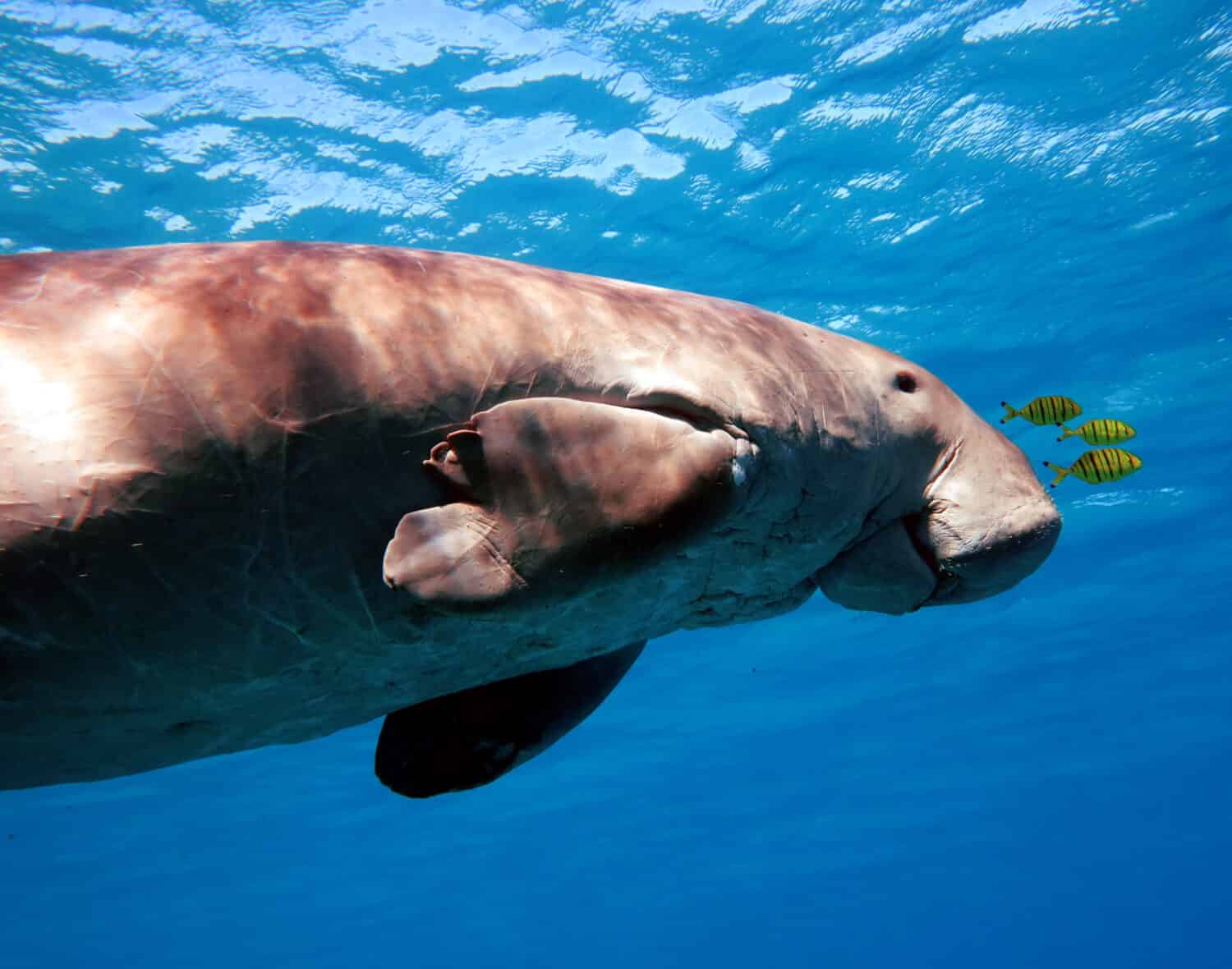
While dugongs’ skin is smooth, it also has hair.
©RomanMr/Shutterstock.com
When baby dugongs are born, their skin is a light cream color. As they grow older, their skin becomes a darker slate-gray color, and their bellies have a lighter gray hue. Some dugongs may have a slightly different coloration as well if they have algae growing on their skin. Dugong skin is sleek and smooth, but they actually do have hair too! Their hair is short and fragile and grows in sparse patches about 1 to 2 inches apart. They don’t have any hair at all on their flippers, and not much on their bellies. Most of their hair grows on their backs.
However, dugongs do have a bunch of bristly, backward-facing hairs on their strong snouts. Dugongs have big, flat mouths that mostly consist of that big upper lip that sticks out over their mouths. When they graze on seagrass along the ocean floor, dugongs look kind of like living vacuum cleaners with adorably scruffy facial hair!
7. They Can’t See Well — But Their Hearing Is Superb

Because of their tiny eyes, dugongs can’t see very well.
©Alex Churilov/Shutterstock.com
A dugong has pretty small eyes. Because of this, they can’t see very well — so they use their excellent sense of touch and superb hearing instead. When they communicate with one another, dugongs use a combination of different sounds as well as physical touch. They use sounds like barks, whistles, and chirps, which all echo underwater. Different sounds and different combinations of sounds all carry different meanings in their complex language.
In addition to their excellent hearing, dugongs also use physical touch to communicate. Mothers and their babies share a strong bond and are especially tactile. They remain in constant physical contact whenever possible. Baby dugongs have even been known to reach out and touch their mothers for support when they are nervous or insecure.
8. Dugongs Can Stand on Their Tails

When dugongs surface for air, they use their tail to stand upright in the water.
©Dray van Beeck/Shutterstock.com
Even though dugongs live in the ocean, they are mammals and need to return to the surface regularly to breathe. Dugongs can hold their breath for about six minutes at a time. While they often spend their time in shallower waters, they can also dive down almost 100 feet into the ocean! Their nostrils are on top of their snouts, so they can pop their heads out of the water just a bit to take in some fresh air. Dugongs have surprisingly good balance and acrobatic skills — when they come up for air, they use their powerful tails to “stand” completely upright in the water! They also have unique valves in their nostrils to prevent water from seeping in when they dive back down into the ocean.
9. Legends of Mermaids Might Have Originated from Dugongs

The name “dugong” means “lady of the sea” in the Malay language.
©vkilikov/Shutterstock.com
The way that dugongs gracefully lift their heads out of the ocean’s waters is not unlike ancient descriptions of sirens and merfolk in mythology. Many historians believe that these enchanting marine mammals may have inspired many of the ancient mermaid legends. In fact, “dugong” comes from the Malay language and means “lady of the sea”.
In fact, many legends in the Pacific nation of Palau tell of young women who transformed into these gentle underwater grazers. There are also several wooden carvings across the coasts that bear witness to countless stories of dugongs aiding fishermen who were lost at sea. Dugongs play a crucial lore in many of the traditional ceremonies and ancient lore of Palau, connecting the people to their environment and their ancestors.
10. Dugongs Are in Danger of Extinction
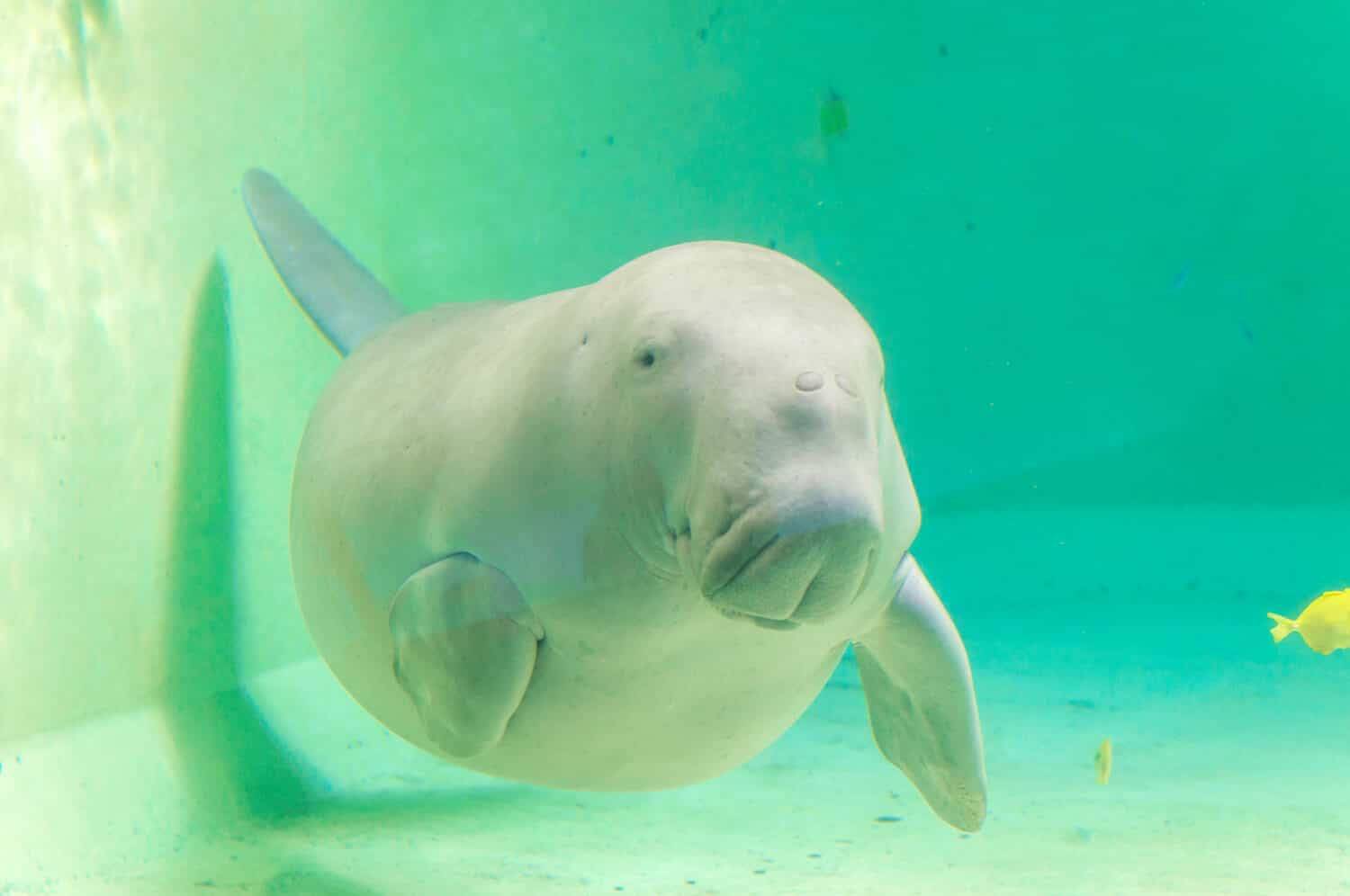
Unfortunately, these fascinating creatures are in danger of extinction.
©Japan’s Fireworks/Shutterstock.com
Adult dugongs don’t have many natural predators, but baby dugongs are often hunted by killer whales, crocodiles, and sharks. However, due to human activities, dugongs are now in danger of going extinct (much like their now-extinct cousins, the Stellar’s sea cow). In fact, while dugongs once peacefully lived in the ocean waters of southern China, they are now officially deemed “functionally extinct” in that region. This is due to human hunters, habitat loss, and collisions with ships.
Dugongs are slow and peaceful animals, which makes them easy targets for human hunters. For many years dugongs were hunted for their meat, skin, bones, oil, and teeth. In most areas, dugongs are now legally protected, so it is illegal to hunt them, although poachers still attempt to do so. However, dugongs are still accidentally caught in commercial fishing nets and hit by boats, and they suffer from habitat damage and loss from human activity and pollution. Dugongs are considered a vulnerable species due to their dwindling populations, and their future survival is quite precarious. Without human intervention and conservation efforts, we could lose these amazing animals forever.
We can help dugongs in many ways, like watching for dugongs when you go boating. They can be hard to spot when they come up to the surface to breathe, so be sure to keep an eye out for them, especially if you know the area is shallow or contains seagrass. Don’t drag your boat over seagrass meadows. In addition, don’t buy products made from dugongs (such as leather, jewelry, charms, or traditional medicine). This promotes dugong hunting and the illegal selling of their hides. Lastly, you can work to ditch single-use plastic whenever possible — even small, everyday changes can make a big difference in protecting incredible marine life like dugongs.
The photo featured at the top of this post is © Alex Churilov/Shutterstock.com
Thank you for reading! Have some feedback for us? Contact the AZ Animals editorial team.






